European goldenrod is one of the few species of its genus native to Europe and Asia rather than North America. It is also a plant with a long history of medicinal use in both European and in Middle Eastern traditions. Today, it is still a popular medicinal herb, and its efficacy is even recognized by the medical community.
Goldenrod Medicinal Properties
- Medicinal action Anti-inflammatory, Diuretic
- Key constituents Flavonoids, polyphenols, saponins, triterpenes
- Ways to use Capsules, Hot infusions/tisanes, Liquid extracts, Tincture, Essential oil
- Medicinal rating (2) Minorly useful plant
- Safety ranking Safe
Health Benefits of Goldenrod
Goldenrod has long been used as an herbal remedy, and it is most commonly used to treat or prevent conditions that cause inflammation in the urinary tract. The main benefits of goldenrod include:
Removing body toxins. Goldenrod has the ability to promote urination, which helps the body eliminate waste products and excess of fluids.
Reducing swelling. Additionally, thanks to its diuretic action, goldenrod can lessen inflammation in the body, particularly in the urinary tract.
So far, goldenrod has been shown to have anti-inflammatory, antimicrobial, diuretic, antispasmodic, and analgesic properties. A variety of preparations using the herb have been prescribed for centuries, and it is still widely recommended, especially for treatment of infections and inflammation, as well as to prevent formation of kidney stones and also to remove them.
The medicinal properties of goldenrod have also been traditionally used to heal wounds, as well as to treat asthma, tuberculosis, diabetes, liver diseases, gout, hemorrhoids, internal bleeding, and arthritis. In folk medicine, it is used as a mouth rinse to treat mouth and throat inflammation.
How It Works
The health benefits of goldenrod appear to be linked to its flavonoids, polyphenols, saponins, triterpenes, and essential oil. However, no single ingredient has been found to be responsible for its medicinal actions.1
By regulating the chemical process of vasoactive peptides (hormones that stimulate the secretion of water and electrolytes), goldenrod has been shown to balance the amounts of water and sodium in the body, increasing urination and reducing swelling. Likewise, it supports cardiovascular function by promoting vasodilatation.2
The important presence of polyphenols - particularly rosmarinic and chlorogenic acids - in goldenrod seems to be partly responsible for its antioxidant, anti-inflammatory, and bile flow-enhancing properties.
Other herbs with great cleansing, diuretic properties are artichoke, asparagus, celery, and stonebreaker, which is also very effective for treating kidney stones.
Goldenrod Side Effects
Goldenrod is considered safe for consumption. However, it may cause allergic reactions in people sensitive to plants in the Asteraceae family, with symptoms including itchy or watery eyes, sneezing, and a runny nose.
On the other hand, many people mistakenly believe they have an allergy to goldenrod when they are in fact allergic to ragweed, a plant that often grows nearby. In any case, a doctor should be consulted before using goldenrod if there is a potential allergy.
Goldenrod Cautions
Goldenrod has no known medical interactions. However, pre-existing conditions must be evaluated before taking the herb in any form.
Goldenrod may cause an adverse reaction in those with kidney or heart disease, as well as in people who suffer from high blood pressure.
Some studies claim it to be safe for those who are pregnant or breastfeeding, but further research is necessary to substantiate these claims.
People with a known hypersensitivity or allergy to Asteraceae plants, or to goldenrod specifically, should avoid consuming the herb altogether.
Goldenrod should not be the sole method used to treat urinary tract infections, as many of these require antibiotics and could develop into a more serious illness if left untreated.

How to Consume Goldenrod
- Edible parts Flowers, Leaves, Stem
- Taste Aromatic
Although goldenrod is edible, it is much more likely to be used as a remedy than as a culinary ingredient.
While every part of the goldenrod plant is edible, it is not commonly eaten, possibly because it is blamed for many spring allergies, such as hayfever. It can be added to salads or soups, as well as into cooked or baked dishes.
Natural Forms
- Infusion. The brewed leaves of goldenrod can help to flush liquids from the body, and it is also a potent anti-inflammatory.
Herbal Remedies & Supplements
Tincture. Goldenrod tincture is very concentrated, which means that just a few drops per day can provide the same diuretic and anti-inflammatory effects.
Extract. An extract is concentrated, similar to a tincture, but does not use alcohol as a solvent and so may be preferable. It is also useful for reducing swelling and promoting urination.
Oil. Goldenrod essential oil should not be consumed internally, but it can be applied to the skin to heal wounds and reduce inflammation.
Capsules. Capsules are a fast and easy way to experience the diuretic and anti-inflammatory properties of goldenrod in fixed, daily doses.
The benefits of goldenrod for the urinary system are potentiated when combined with other herbs with similar properties, like burdock, horsetail, and stonebreaker.

Growing
- Life cycle Perennial
- Harvested parts Flowers, Leaves, Stem
- Light requirements Full sun, Partial shade
- Soil Well-drained
- Soil pH 5.1 – 5.5 (Strongly acidic), 5.6 – 6.0 (Moderately acidic), 6.1 – 6.5 (Slightly acidic), 6.6 – 7.3 (Neutral)
- Growing habitat Cool temperate regions, Temperate climates, Warm climates
- Planting time Early spring, Spring, Fall
- Plant spacing average 0.6 m (1.97 ft)
- Potential insect pests Beetles
- Potential diseases Root rot, Powdery mildew
While the goldenrod plant is often thought of as a weed, it can be a beautiful ornamental when grown in a garden. It requires very little care and maintenance, and its yellow blooms attract pollinators like bees and butterflies.
Growing Guidelines
Goldenrod can be propagated by both seeds and rhizomes; however, plant seedlings are also available for purchase in garden centers or nurseries.
If planting a seed or rhizome, goldenrod can be sown outdoors either during the fall or the spring, as it will germinate regardless of the season when planted.
If planting seedlings, these should be kept indoors through the winter and be transferred outdoors in late spring.
The best soil for goldenrod is moist but well-drained and moderately fertile.
Goldenrod plants should be spaced one to two feet (30 - 60 cm) apart.
Seeds should be sown at a depth of 0.25 inches (0.6 cm).
Goldenrod can be planted in full sun or partial shade, as it has adapted to both sunny environments in meadows and shadier conditions in forests.
It is advised to water goldenrod fairly frequently in dry areas, as goldenrod requires 16 - 60 inches (200 - 1,500 mm) of rain annually.
In order to keep goldenrod from spreading, the flower heads should be removed before the seeds can ripen.
Goldenrod is susceptible to powdery mildew and root rot.
Bugs such as blister beetles, goldenrod beetles, and casebearers may damage the goldenrod plant.
Additional Information
- Other uses Dye, Fertilizer
Plant Biology
Goldenrod is a perennial species, generally growing three to five feet (1 - 1.5 m) tall and two to three feet (60 - 100 cm) wide. It is known for its bunches of small yellow flowers, which grow on small flower heads at the top of every stem.
Classification
European goldenrod (Solidago virgaurea), belongs to the Asteraceae family, also known as the aster or sunflower family, which contains numerous flowering plants, notably including artichoke, chicory, dandelion, marigold, lettuce, and sunflower. The genus name Solidago comes from the Latin words solidus, meaning "whole," and ago, meaning "to make," in reference to the medicinal healing properties of some of its species.
Related Species and Varieties of Goldenrod
Over 100 species belong to the genus Solidago - about 80 of them are native to North America, and all of them are referred to as goldenrods. Some of the most common wild-growing goldenrods are Canada goldenrod (S. canadensis) and tall goldenrod (S. gigantean).
There are over 30 varieties of European goldenrod (Solidago virgaurea) in North America, all smaller in size but tidy, most reaching up to two feet (60 cm). Among the most popular ones for gardening are 'Baby Sun', 'Crown of Rays', 'Cloth of Gold', 'Golden Mosa', and 'Peter Pan'.
Historical Information
European goldenrod, S. virgaurea, is native to most of Europe and now grows wild across Asia, North Africa, and South America. It was cultivated and used in traditional Arabic medicines for thousands of years, and it was likewise used in European traditional medicine, mostly to heal wounds.
The inventor Thomas Edison created experiments to discover if he could use goldenrod to produce useful amounts of rubber, which is a natural component of the goldenrod plant. He succeeded in breeding a cultivar that produced more rubber than the wild goldenrod plant.
After the Boston Tea Party during the American Revolution, many patriotic Americans would drink tea made from goldenrod, also called freedom tea. In fact, goldenrod was one of the flowers that was considered for the national flower. Although the rose eventually won the honor of the national flower, goldenrod has since been named the state flower of Kentucky and Nebraska.
Popular Beliefs
The Meskwaki, a native American tribe, would use goldenrod to treat learning impairments. They believed that an infusion made of goldenrod and the bones of an animal that died the day the child was born would improve the child's ability to talk or laugh.
Other Uses
Decoration. Hybrids of goldenrod have been developed to be used as cut flowers for floral arrangements.
Fertilizer. Goldenrod is sometimes used in agriculture to improve soil quality.
Industry. The flowers of goldenrod produce a green dye. Additionally, the plant's rubber component has some industrial uses, although rubber is more commonly synthetically produced in modern times.
Alcohol. Goldenrod has also been used in the production of wine.
Despite its bad reputation with allergies, goldenrod is a valuable medicinal plant, most useful for its diuretic and anti-inflammatory properties.
Sources
- Clinical Naturopathic Medicine, p. 482
- Edible & Medicinal Flowers, p. 40
- European Medicines Agency, Assessment Report on Solidago virgaurea L., 2008
- Hamilton University, Golden Rod
- Journal of Urology, Botanical medicines for the urinary tract, 2002
- Medicinal and Other Uses of North American Plants, p. 390
- Missouri Botanical Garden, Solidago virgaurea subsp. minuta
- Penn State University, Milton S. Hershey Medical Center, Goldenrod
- Phytopharmacy: An Evidence-Based Guide to Herbal Medicinal Products, pp. 180 - 181
- The Book of Field and Roadside, p. 146
- USDA Plants Database, Canada Goldenrod
Footnotes:
- Hortorum Cultus. (2014). Chemical Characteristics of European Goldenrod. Retrieved June 15, 2023, from: https://www.semanticscholar.org/paper/Chemical-characteristics-of-European-goldenrod-L.-Roslon-Osi%C5%84ska/d2160059a2d3ab6d93221841601b440e008e1c9b
- Wiener medizinische Wochenschrift. (2004). Goldenrod--A Classical Exponent in the Urological Phytotherapy. Retrieved June 15, 2023, from: https://pubmed.ncbi.nlm.nih.gov/15638071/






